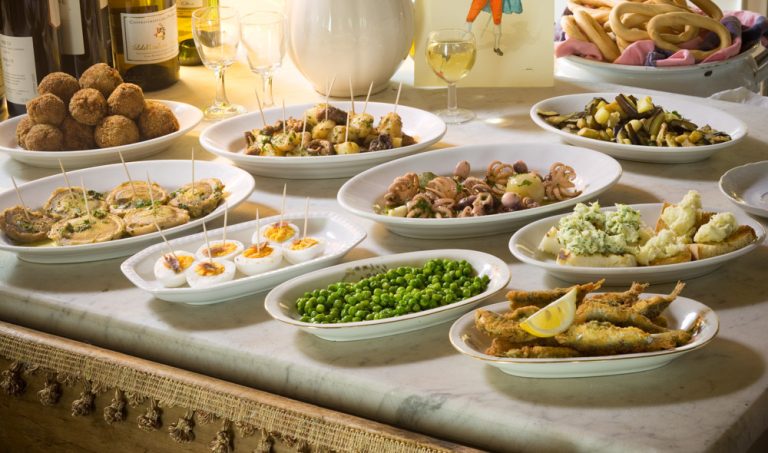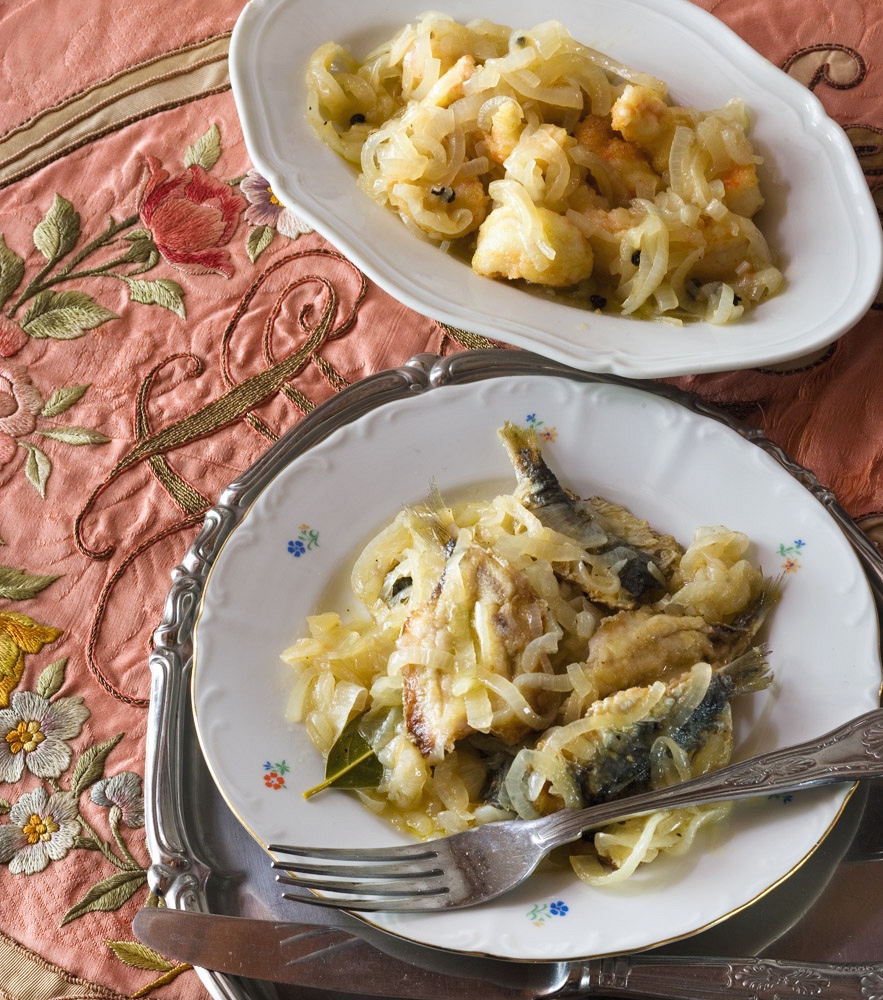@italysegreta Cicchetti Venezia
Find the story I wrote on cicchetti (the traditional small bites) from Venice, as well as a few other recipes from my book 'Venezia' on @italysegreta's newsletter
Photography by Manos Chatzikonstantis



SARDE IN SAOR - SARDINES SOUR
Every Venetian I have met loves sardines prepared like this – in saor means literally 'in a sour sauce'.
They make a great snack if you have a crowd to feed – not only because you can easily make many batches, but because they keep so well in the fridge & improve with flavour. If making more batches you will need to wipe out the pan so the excess flour on the bottom doesn't burn.
If you like, you can add in – as many Venetians do – a handful of pine nuts & raisins to the onions. I use smallish sardines – you can leave the tails on or off as you prefer.
about 125 ml(4 fl oz/½ cup} olive oil
400 g (14 oz) white onions, halved & thinly sliced
a few whole peppercorns, gently squashed
2 bay leaves
125 ml (4 fl oz/ ½ cup) white wine vinegar
15-18 whole sardines, about 500 g (1 lb 2oz)
flour, for dusting
light olive oil, for frying
Heat the oil in a non-stick frying pan with a lid, add the onions & cook over medium heat. After a few minutes, add the peppercorns, bay leaves & some salt & pepper. Put the lid on, lower the heat & simmer for 20-25 minutes. The onions must not brown, but be well softened & nicely cooked, so check from time to time that not all the liquid has been absorbed. If the onions are browning too much, add a few drops of water & carry on simmering. Once they are soft & cooked down, add the vinegar & simmer without the lid for another 5-10 minutes until reduced a little, leaving the onions covered in a lovely sauce, but don't let them dry out.
Meanwhile, to fillet the sardines, cut off the heads, then make a slit down the undersides of each & remove the guts. Open out the sardines like a book so that they are still hinged together, & place, skin side up on a chopping board. Press each sardine lightly, yet firmly, to open out. Turn each over & pull out the backbone (or leave in the bone & just clean them while you are eating them). Rinse & pat dry. Pat well in the flour to coat on both sides.
Pour enough oil into a large non-stick frying pan to cover the bottom abundantly. When the oil is hot add the sardines, turning them only when they are crisp on the bottom. If the flour is falling off & sticking to the bottom, you may need to reduce the heat a touch. When both sides are golden & quite crisp, remove to a plate lined with kitchen paper to absorb the excess oil. Sprinkle with fine salt.
Layer the sardines & onions in a compact bowl. A layer of sardines, a layer of onions & the peppercorns, a sprinkle of pepper here & there - & so on. Add a little more olive oil if it looks like it needs it & an extra sprinkle of salt.
Cover & either leave at room temperature if you will be eating them in the next few hours, or put in the fridge where they will keep for a few days, soaking up the flavours more. Each time you eat a sardine, rotate a few of them so they are all covered & not just the underneath ones.
photo by Manos Chatzikonstantis, styling by Michail Touros
SCAMPI IN SAOR - SCAMPI SOUR
My friend, Sergia, once made me a wonderful batch of these to carry home on the train with me & they were absolutely delicious.
The scampi must be lovely & fresh.
18-20 scampi (langoustines, red-claw or large prawns)
125 ml(4 fl oz/½ cup} olive oil
400 g (14 oz) white onions, halved & thinly sliced
a few whole peppercorns, gently squashed
2 bay leaves
3 tablespoons white wine
125 ml (4 fl oz/ ½ cup) white wine vinegar
flour, for coating
light olive oil, for frying
Peel the scampi. Remove the tail meat by cutting down the centre of the underside of the tail with small sharp scissors & using your fingers to pull out the meat. Devein, wash, pat dry & leave in the fridge.
Heat the oil in a non-stick frying pan with a lid & cook the onions for a few minutes before adding the peppercorns, bay leaves & some salt. Cover, lower the heat & simmer for 20-25 minutes until well softened but not browned. Check from time to time that not all the liquid has been absorbed. Add the wine, let it bubble up a bit, then add the vinegar & simmer, uncovered now, for another 5-10 minutes until cooked out a bit, but still saucy.
Put some flour on a plate & coat the scampi well.
Pour enough oil into a large non-stick frying pan to cover the bottom abundantly. When the oil is hot add the scampi, turning them only when they are crisp on the bottom. If the flour is falling off & sticking to the bottom, you may need to reduce the heat a touch. When both sides are golden & quite crisp, remove to a plate lined with kitchen paper to absorb the excess oil. Sprinkle with fine salt.
Put half the onion in a small bowl, top with the scampi & cover with the remaining onion. Scatter with some pepper, a little more salt & a little olive oil if you think it needs it.
Cover & either leave at room temperature if you will be eating them in the next few hours, or put in the fridge where they will keep for a few days, soaking up the flavours more & more.
photo by Manos Chatzikonstantis, styling by Michail Touros

